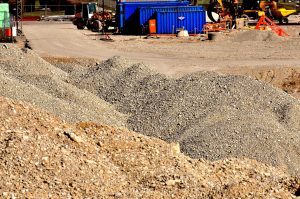 Print a Sign-In Sheet | Spanish Version
Print a Sign-In Sheet | Spanish Version
What Is Crystalline Silica?
Crystalline silica is a basic component of soil, sand, granite, and many other minerals. Quartz is the most common form of crystalline silica. Cristobalite and tridymite are two other forms of crystalline silica. All three forms may become respirable size particles when workers chip, cut, drill, or grind objects that contain crystalline silica.
What Are the Hazards of Crystalline Silica?
- Silica exposure remains a serious threat to nearly 2 million U.S. workers.
- High-risk jobs include: abrasive blasting, foundry work, stonecutting, rock drilling, quarry work, and tunneling.
- Crystalline silica has been classified as a human lung carcinogen.
- Breathing crystalline silica dust can cause silicosis, which in severe cases can be disabling, or even fatal.
- The respirable silica dust enters the lungs and causes the formation of scar tissue, thus reducing the lungs’ ability to take in oxygen.
- There is no cure for silicosis.
- Since silicosis affects lung function, it makes one more susceptible to lung infections like tuberculosis. In addition, smoking causes lung damage and adds to the damage caused by breathing silica dust.
Where Are Construction Workers Exposed to Crystalline Silica?
Exposure occurs during many different construction activities including:
- Abrasive blasting with sand to remove paint and rust from bridges, tanks, concrete structures, and other surfaces.
- Jackhammering.
- Rock/well drilling.
- Concrete mixing and drilling B.
- Brick and concrete block cutting.
Where Are General Industry Employees Exposed to Crystalline Silica Dust?
General Industry exposures to crystalline silica result from a variety of manufacturing and maintenance applications, including:
- Abrasive blasting, grinding, and cleaning.
- Removal of paint, oils, rust, or dirt from objects to be repainted or treated.
- Brick manufacturing.
- Asphalt pavement manufacturing.
- China and ceramic manufacturing.
- Tool and die, steel. and foundry industries.
What Can Employers/Employees do to Protect Against Exposures to Crystalline Silica?
- Replace crystalline silica materials with safer substitutes whenever possible.
- Provide engineering or administrative controls where feasible, such as local exhaust ventilation and blasting cabinets. Where necessary to reduce exposures below the permissible exposure limit, use protective equipment or other protective measures.
- Use all available work practices to control dust exposures, such as water sprays.
- Wear only a N95 National Institute for Occupational Safety and Health (NIOSH) certified respirator if respirator protection is required. Do not alter the respirator. Do not wear a tight-fitting respirator with a beard or mustache that prevents a good seal between the respirator and the face.
- Wear only a Type CE abrasive-blast supplied-air respirator for abrasive blasting.
- Wear disposable or washable work clothes and shower if facilities are available. Vacuum the dust from your clothes or change into clean clothing before leaving the worksite.
- Participate in training, exposure monitoring, and health screening and surveillance programs to monitor any adverse health effects caused by crystalline silica exposures.
- Be aware of the operations and job tasks creating crystalline silica exposures in your workplace environment and know how to protect yourself.
- Be aware of the health hazards related to exposures to crystalline silica. Smoking adds to the lung damage caused by silica exposures.
- Do not eat, drink, smoke, or apply cosmetics in areas where crystalline silica dust is present. Wash your hands and face outside of dusty areas before performing any of these activities.
- Establish and implement a written exposure control plan.
- Designate a competent person to implement the written exposure control plan.
- Restrict housekeeping practices that expose workers to silica.
- Offer medical exams, including chest x-rays and lung function tests, every three years for workers who are required by the standard to wear a respirator for 30 or more days per year.
- Train workers on the health effects of silica exposure, workplace tasks that can expose them to silica, and ways to limit exposure.
- Keep records of workers’ silica exposure and medical exams.
- Remember, if it’s silica, it’s not just dust.
Employers who do not fully implement control methods, such as engineering and work practice controls, must:
- Determine the amount of silica that workers are exposed to if it is, or may reasonably be expected to be, at or above the action level of 25 ug/m3 (micrograms of silica per cubic meter of air) averaged over an 8-hour day.
- Protect workers from respirable crystalline silica exposures above the permissable exposure limit (PEL) of 50 ug/m3 averaged over an eight-hour day.
- Use dust controls and safer work methods to protect workers from silica exposures above the PEL.
- Provide respirators to workers when dust controls and safer work methods cannot limit exposures to the PEL.
KEMI does not assume liability for the content of information contained herein. Safety and health remain your responsibility. This information is to be used for informational purposes only and not intended to be exhaustive or a substitute for proper training, supervision, or manufacturers’ instructions/recommendations. KEMI, by publication of this information, does not assume liability for damage or injury arising from reliance upon it. Compliance with this information is not a guarantee or warranty that you will be in conformity with any laws or regulations nor does it ensure the absolute safety of any person, place, or object, including, but not limited to, you, your occupation, employees, customers, or place of business.

